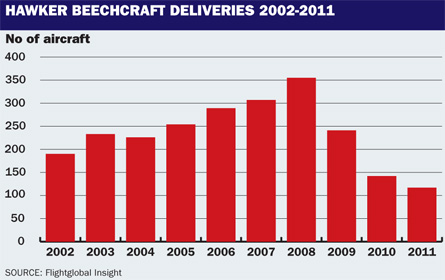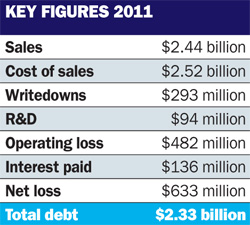Hawker Beechcraft marks its 80th birthday this year. Whether the anniversary is a celebration or the last milestone may be decided in the next few weeks as management scrambles to restructure a debt burden that has brought the Wichita-based business and special-missions aircraft maker to the brink.
The numbers are not pretty. According to the company's 2011 annual report, last year Hawker Beechcraft made sales of $2.44 billion but burned through more than $2.5 billion in cost of sales and spent another $94 million on R&D.
Then it got worse; $293 million written off of assets and goodwill, $136 million for interest and another $134 million in "non-operating expense" made for a pre-tax loss of $615 million. Taxes took a chunk, too - net loss, $633 million. In 2010 the bottom line was a $305 million loss; $452 million went down the pipes in 2009.

Critically, total debt as of end-2011 stood at more than $2.3 billion. All in, assets were on the books at less than $2.8 billion.
BOOM AND BUST
The origins of the crisis lie in the mid-2000s business jet boom. In 2007, Goldman Sachs and private equity house Onex Partners bought what was then Raytheon Aircraft from the weapons systems maker for $3.3 billion. In retrospect the purchase price was optimistic. The 2008 financial crisis has left the business jet market in tatters, and while firms like Dassault or Gulfstream which make large-cabin models are seeing some recovery, Hawker Beechcraft's small-to-midsize sector remains in depression.
According to Hawker Beechcraft, the terms of the loan that bought the company in 2007 became unrealistic after the crash. A deal reached with lenders this March, for $120 million in new liquidity and "forbearance" until 29 July on some of Hawker Beechcraft's interest payments, has bought some time.
Newly-hired chief executive Robert "Steve" Miller - a self-proclaimed "Turnaround Kid" whose patients include the once near-dead icons American International Group and Chrysler - promises fast action: "In the coming weeks, we expect to decide on a path forward that will... put the company on a firm financial footing."
The company refuses to comment further than that, but is thought not to want a Chapter 11 filing. Unlike, say, American Airlines, Hawker Beechcraft is happy with its union contracts.
 But Miller's options for this "path forward" look limited to pleading for more forbearance from lenders and getting Goldman and Onex to dig into their deep pockets for more cash. Hawker Beechcraft's 2011 report couldn't be starker: "Management has concluded that there is substantial doubt about the company's ability to continue as a going concern."
But Miller's options for this "path forward" look limited to pleading for more forbearance from lenders and getting Goldman and Onex to dig into their deep pockets for more cash. Hawker Beechcraft's 2011 report couldn't be starker: "Management has concluded that there is substantial doubt about the company's ability to continue as a going concern."
Debt certainly limits investment but the problem is deeper. Miller points to three years of "aggressive transformational changes", which suggests there is little room for cost cutting. Even if 2011 saw the last of the major asset writedowns and if interest expenses were slashed, the company is still a loss maker.
The real problem is the top line. Market analyst and Teal Group vice-president Richard Aboulafia sums up Hawker Beechcraft's dilemma: "Market recovery is anaemic at best." Hawker Beechcraft, he says, needs to be free of its debt burden and needs a serious cash commitment from its owners so it can operate in a manner that assures its customers the company has a future.
The small- to mid-size market will recover eventually, Aboulafia reckons, but in the meantime relative giant Embraer is muscling in with its Legacy models. Defence markets are weak.
Barring bankruptcy, says Aboulafia, one option for Hawker Beechcraft is to stretch its range up into larger-cabin aircraft, where sales are stronger and margins better - but that would take lots of money. A second option is to be acquired.
Meanwhile, Miller insists that nothing will change "Hawker Beechcraft's commitment and ability to build, sell and service the best airplanes for our civilian and military customers".
Nothing, that is, except the end of the road.
Source: Flight International




















